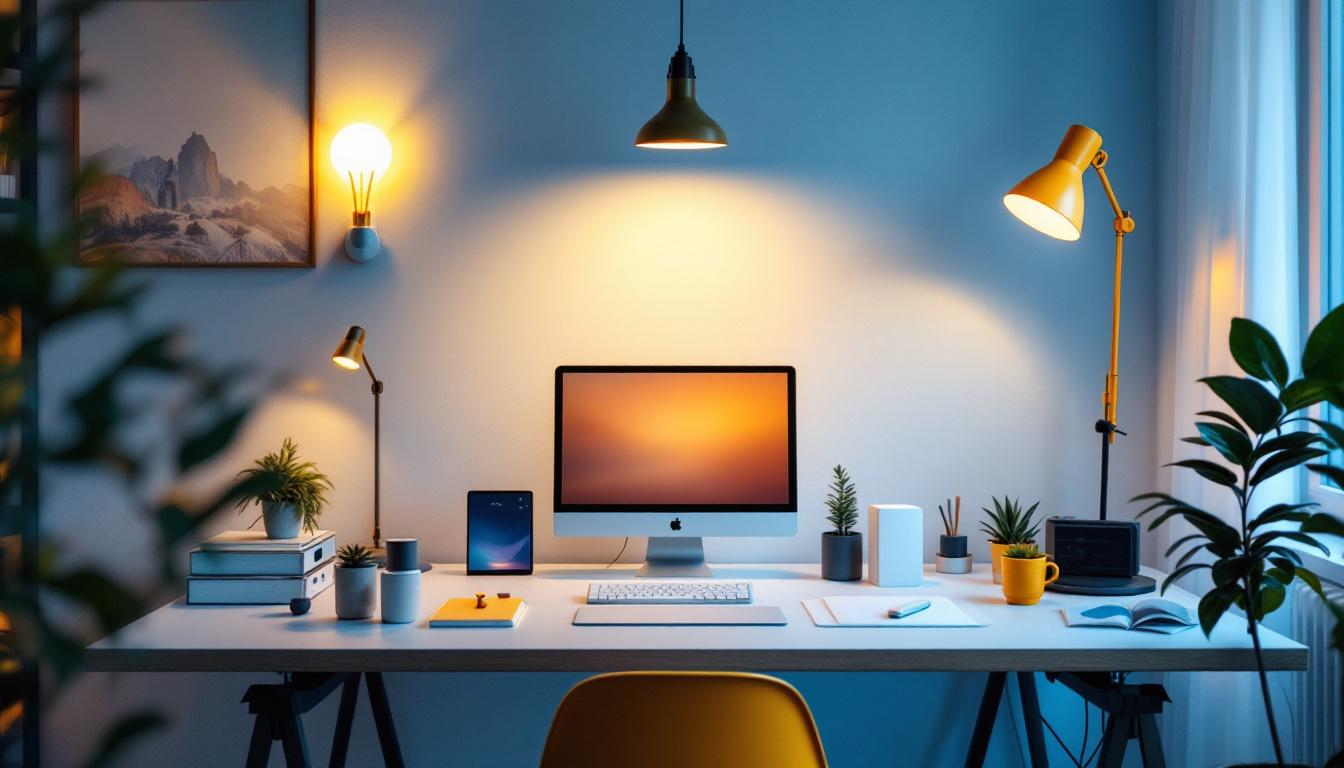
In the evolving landscape of home office design, lighting plays a pivotal role in enhancing productivity and creating a conducive work environment. For lighting contractors, understanding the nuances of smart lighting solutions can set them apart in a competitive market. This article delves into innovative hacks and strategies that can help contractors optimize light fixtures for home offices, ensuring both functionality and aesthetic appeal.
The significance of proper lighting in a home office cannot be overstated. It not only affects the visual comfort of the workspace but also influences the overall mood and productivity of individuals. Poor lighting can lead to eye strain, headaches, and decreased focus, making it essential for contractors to recommend appropriate lighting solutions. A well-lit office can enhance creativity and reduce fatigue, ultimately leading to a more enjoyable and efficient work experience.
There are three primary types of lighting that should be considered when designing a home office: ambient, task, and accent lighting. Ambient lighting provides overall illumination, while task lighting focuses on specific areas where work is performed, such as desks or reading nooks. Accent lighting, on the other hand, adds a decorative touch, highlighting artwork or architectural features. Each type of lighting serves a distinct purpose and can be combined in various ways to create a harmonious and functional workspace.
Contractors should evaluate the unique needs of each workspace to determine the best combination of these lighting types. For instance, a space with ample natural light may require less ambient lighting, allowing for more emphasis on task and accent lighting. Additionally, the use of dimmable fixtures can provide flexibility, allowing users to adjust the brightness according to their specific needs throughout the day. This adaptability is particularly beneficial in home offices where tasks can vary significantly from research and writing to video conferencing and creative brainstorming.
Color temperature, measured in Kelvin (K), plays a crucial role in setting the atmosphere of a home office. Warmer tones (around 2700K to 3000K) create a cozy and inviting environment, while cooler tones (above 4000K) promote alertness and concentration. Understanding the psychological effects of color temperature can help contractors make informed recommendations to clients. In addition to enhancing productivity, the right color temperature can also influence how individuals perceive their work environment, making it feel more spacious or intimate depending on the chosen hue.
When designing a lighting plan, it’s beneficial to consider the time of day and the tasks being performed. For example, warmer lighting may be ideal for late afternoon hours, while cooler lighting can be more effective during morning work sessions. Moreover, incorporating adjustable lighting solutions, such as smart bulbs or color-changing LEDs, allows users to tailor their environment to their preferences and needs. This level of customization not only fosters a more personalized workspace but also encourages a healthier work-life balance, as individuals can create a setting that transitions seamlessly from focused work to relaxation at the end of the day.
As technology advances, smart lighting solutions have become increasingly popular in home office settings. These systems offer flexibility, energy efficiency, and enhanced control over lighting conditions. Contractors should be well-versed in the various options available to provide clients with tailored solutions that meet their specific needs.
Smart bulbs are a versatile option for home offices, allowing users to adjust brightness and color temperature through smartphone apps or voice commands. This adaptability can significantly enhance the user experience, enabling individuals to create the perfect lighting conditions for different tasks or times of day.
Contractors should educate clients on the benefits of smart bulbs, including energy savings and the ability to set schedules or automate lighting based on daily routines. Additionally, compatibility with existing smart home systems can be a selling point, making it easier for clients to integrate new lighting solutions into their current setups.
Dimmers and motion sensors are essential components of a smart lighting strategy. Dimmers allow users to adjust the intensity of light, creating a customizable environment that can adapt to various activities, from focused work to relaxation. Motion sensors, on the other hand, enhance energy efficiency by automatically turning lights on or off based on occupancy.
Incorporating these features not only improves the functionality of the lighting system but also contributes to overall energy savings. Contractors should emphasize the long-term benefits of these installations, as they can lead to reduced energy costs and a smaller carbon footprint.
While functionality is crucial, the aesthetic appeal of lighting fixtures should not be overlooked. The design of light fixtures can significantly influence the overall look and feel of a home office. Contractors must balance style and practicality to create visually appealing and effective lighting solutions.
The selection of light fixtures should align with the overall design theme of the home office. Modern spaces may benefit from sleek, minimalist fixtures, while more traditional settings might call for ornate designs. Additionally, the size and scale of fixtures should be appropriate for the space, ensuring they do not overwhelm or underwhelm the room.
Contractors should also consider the placement of fixtures. Overhead lighting can provide general illumination, but strategically placed task lights can enhance functionality and create visual interest. Layering different types of lighting can add depth and dimension to the space.
Natural light is an invaluable resource in any home office. It not only reduces reliance on artificial lighting but also has numerous benefits for mental health and well-being. Contractors should assess how to maximize natural light in their designs, using window treatments that allow for flexibility in light control.
Incorporating reflective surfaces, such as mirrors or glossy finishes, can also help distribute natural light throughout the space. Encouraging clients to position their workstations near windows can enhance their experience and productivity.
With growing awareness of environmental issues, energy efficiency and sustainability have become key considerations in lighting design. Contractors have a unique opportunity to promote eco-friendly practices through their lighting solutions, appealing to environmentally conscious clients.
LED lighting has revolutionized the industry, offering a highly energy-efficient alternative to traditional incandescent and fluorescent bulbs. They consume significantly less energy and have a longer lifespan, making them a cost-effective choice for home office lighting.
Contractors should advocate for the use of LED fixtures and bulbs, highlighting their benefits not only for energy savings but also for reducing the frequency of replacements. Additionally, many LED products are now available in a variety of styles, ensuring that aesthetic preferences can still be met.
Integrating smart controls into lighting systems can further enhance energy efficiency. By allowing users to monitor and adjust their energy consumption, smart lighting solutions can help reduce waste and lower utility bills. Contractors should educate clients on the importance of energy management and how smart controls can contribute to a more sustainable home office.
Encouraging clients to adopt energy-efficient practices, such as turning off lights when not in use or utilizing timers, can also contribute to significant energy savings over time.
Even experienced contractors can make mistakes when designing lighting for home offices. Being aware of common pitfalls can help ensure that the final result meets both the functional and aesthetic needs of the space.
One of the most frequent mistakes is overlooking the importance of layered lighting. Relying solely on overhead fixtures can lead to an uninviting and harsh environment. Instead, incorporating ambient, task, and accent lighting can create a more dynamic and comfortable workspace.
Contractors should encourage clients to think about how they use their space and recommend a mix of lighting solutions that cater to various activities and preferences.
Glare can be a significant issue in home offices, particularly when working on screens. Contractors must consider the positioning of light fixtures to minimize glare and ensure that work surfaces are adequately illuminated without causing discomfort.
Using diffusers or selecting fixtures with adjustable angles can help mitigate glare issues. Additionally, educating clients on the importance of proper screen placement in relation to lighting can further enhance their experience.
As the demand for home office spaces continues to grow, lighting contractors have a unique opportunity to elevate their offerings by providing innovative and effective lighting solutions. By understanding the importance of lighting, integrating smart technologies, and considering design aesthetics, contractors can create spaces that not only look great but also enhance productivity.
With a focus on energy efficiency and sustainability, contractors can position themselves as leaders in the industry, appealing to clients who value both style and environmental responsibility. By avoiding common mistakes and embracing a holistic approach to lighting design, contractors can ensure that their clients enjoy a well-lit, functional, and beautiful home office environment.
Ultimately, the right light fixture can transform a home office from a mundane workspace into a vibrant hub of creativity and productivity. By leveraging these hacks and insights, lighting contractors can make a lasting impact in the homes they work in.
Ready to elevate your home office lighting projects with the finest fixtures on the market? Look no further than LumenWholesale, where we offer an extensive range of spec-grade lighting products tailored to the needs of discerning contractors. Our commitment to quality, affordability, and convenience ensures that you can access the best lighting solutions without the usual markups. Plus, with free shipping on bulk orders, you can stock up on everything you need to create productive and aesthetically pleasing home office environments. Don’t compromise on quality or price—discover the best value in wholesale lighting today and make a lasting impression on your clients.

Discover everything lighting contractors need to know about high pressure sodium ballasts in this comprehensive guide.

Discover the essential best practices lighting contractors use to optimize fluorescent lighting installations.

Discover why opting for local distributors when buying commercial lighting in bulk might not be the best choice.

Discover how undercabinet lighting can transform your contracting business.